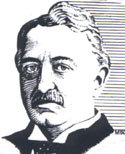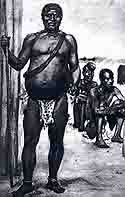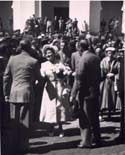‘POTTED’ HISTORY – Matabeleland/Southern
Rhodesia Southern
Rhodesia’s history is more complex and diverse than the
following short chronological table suggests. Deeply committed
men and women of all creeds, nationalities and political persuasions
have played their part in its rich and bitterly contested past.
I
lived there from 1948 to 1963 (from 4 to 20 years of age), and
my memories of those years are of a happy and carefree childhood
and adolescence in a small close-knit colonial and Christian
community in Bulawayo, Matabeleland. The selection of the importance
of events ties in with my memories of those years.
My
short history starts with Mzilikazi’s migration northwards
into Central Africa, where he settled south of the Zambezi River.
I flew to London in March 1963, and my history concludes as the
Federation of the Rhodesias and Nyasaland is about to be dissolved.
I
have refreshed and updated my knowledge as best I can in the
limited time I have available during my course, and apologise
if I inadvertently offend any users of this website.
1817 Mzilikazi,
Tshaka’s greatest general flees from his wrath, treks northward,
and later founds the Matabele nation at Bulawayo.
1855 Dr David Livingstone, the famous Scottish
missionary ‘discovers’ the Victoria Falls.
1859 Inyati Mission, first permanent
European settlement, founded by Dr Robert Moffat.
1870 Lobengula, son of Mziligazi,
installed as King of the Matabele.
1888 Rudd concession granted
to Rhodes by Lobengula, giving him the mineral rights
of the territory.
1890 Pioneer column reaches Harari
Hill, and founds Fort Salisbury
1891 Order-in-Council declaring
British Protectorate over Bechuanaland, Matabeleland
and Mashonaland.
1892 First land settlement Scheme
announced. Beira Railway Company floated.
1893 Matabele Impi attacks Mashonas
at Fort Victoria. War on the Matabele authorised. The
Chartered Company’s force occupies Lobengula’s
kraal, the present site of Bulawayo. Major Allan Wilson
and his patrol annihilated near Shangani River.
1894 Death of Lobengula presumed.
1896 Matabeleland and Mashonaland
rebellions – murders of settlers. Rhodes with unarmed
party visits the Matopos and parleys with chiefs. Official
submission of Matabele chiefs.
1897 Consent to the official use
of the name ‘Rhodesia’. Railway from the
Cape via Mafeking reaches Bulawayo.
1898 Beira
railway reaches Umtali.
1899 Outbreak of the Boer War.
1902 Cecil John Rhodes dies in South Africa and is buried
in the Matopos Hills. Bulawayo-Salisbury railway completed.
1904 Railway to Victoria Falls completed, and goes on
northward. Victoria Falls bridge, 400 ft above water, opened.
1914 Outbreak of World War I.
1918 Armistice.
1920 First London-Cape flight
in the ‘Silver Queen’, crashes at Bulawayo.
Responsible Government debated and approved.
1922 Referendum of voters taken
on question whether Southern Rhodesia (SR) should join
the Union of South Africa or assume Responsible Government.
Majority of votes for Responsible Government.
1923 SR annexed to Great Britain
and Responsible Government established.
1939 Outbreak of World War
II.
1940 Empire Training Schools for
Royal Air Force opened at Salisbury, Bulawayo and Gwelo.
1945 Surrender of all German
armed forces in Europe. Japan surrenders. End of World
War II.
1947 Royal Family visits
Salisbury, Bulawayo and Victoria Falls.
1949 Preliminary conference
at the Victoria Falls on the Federation of Southern
and Northern Rhodesia (NR) with Nyasaland. All Blacks
Rugby Team defeated in Bulawayo by Rhodesia.
1952 Death of King George
VI and Princess Elizabeth proclaimed Queen. Visit of
Newcastle United, the FA Cup-holders.
1953 Final conference on
Federation in London. Central African Rhodes Centenary
Exhibition held in Bulawayo, opened by Queen Elizabeth,
the Queen Mother. Coronation of Queen Elizabeth II
of Great Britain and the British Commonwealth.
1954 Federation of Rhodesia
and Nyasaland formed.
1957 African
National Congress re-forms incorporating the Youth
League and adopts their principle of ‘One Man,
One Vote’.
1958 Hastings Banda returns
to Nyasaland after self-imposed exile in UK, and Kenneth
Kaunda politically active in NR.
1959 African National Congress
is banned in SR.
1960 Harold MacMillan makes
his famous ‘Winds of Change’ speech in
Cape Town on his trip through Africa. National Democratic
Party (NDP) is formed.
1961 Conference is held in
Salisbury and a new constitution, with a voting system
involving A and B rolls, is agreed by all parties,
but after much civil unrest the NDP is banned. The
Zimbabwe African People’s Union (ZAPU), successor
to the NDP, is formed.
1962 Referendum is held on
new constitution – ‘Yes’ vote. Federal
Parliament is dissolved by Sir Roy Welensky. Nyasaland
is given the right to secede from the Federation. ZAPU
follows a policy identical to the NDP but with greater
militancy. ZAPU is banned by the government, and most
of its leaders restricted for 3 months to the area
surrounding their home villages. In the general election
held in December the newly-formed Rhodesian Front party
gains a working majority of five seats. Political detainees
released.
1963 The “break-up” conference
held with British Government at Victoria Falls re the
dissolution of the Federation, and Independence for
SR. NR given the right to secede.
Assassination of President Kennedy.
1964 Federation dissolved.
Back to top
|





